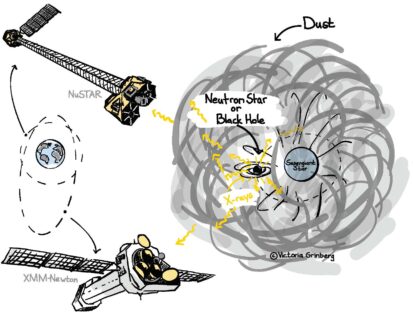Mysterious binary star system in space

FAU research team investigates binary star system using X-ray satellites
Binary stars are well known to astrophysicists. One stellar double-act in particular has drawn their attention, as part of the X-ray radiation that binary star systems usually emit is missing, and the x-rays it did emit seemed to have strange properties. A research team led by FAU observed a binary star system using X-ray satellites to find some answers. Their results were published in the journal ‘Astronomy and Astrophysics’.
Binary star systems are not unusual in space. Even if like IGR J16318-4848, located in one of the spiral arms of our galaxy, one of the partners consists of a neutron star, the ultra-compacted remains of a stellar corpse. Its partner appears to be similarly exotic – a supergiant star that is several times the mass of our sun. On top of that, this monstrous cosmic litterbug blasts out vast amounts of iron into space. ‘Usually, we can detect a broad spectrum of soft and hard X-rays from such systems,’ explains Prof. Dr. Jörn Wilms from the Astronomical Institute of FAU in the Dr. Karl Remeis Observatory in Bamberg. But this system proved a tough nut to crack for astrophysicists not only because the entire soft X-ray radiation was missing but also because the hard X-rays have very surprising properties. Jörn Wilms, his doctoral candidate Ralf Ballhausen and a research team from Germany, the Netherlands, Spain and the USA were only able to solve this problem with the help of two X-ray satellites and computer models, which they used to simulate this mysterious binary system.
The supergiant, the dwarf and a mystery
In this pair of stars, the supergiant, whose true size could not yet be precisely determined, continuously blasts part of its own mass into space as a stellar wind. A neutron star was probably already in orbit there, created when a star that had at least eight times the mass of our sun collapsed at the end of its life to form an extremely compact structure. In this structure, atomic nuclei are packed extremely close together. A teaspoon of this matter would be as heavy as a cube of iron with edges that are 700 metres long. ‘Although it has 1.4 times the mass of our sun, such a neutron star with a diameter of ten kilometres is dwarfed by the 700,000 kilometre diameter of our sun,’ explains Jörn Wilms. If the matter ejected by the supergiant falls onto this super-dense dwarf, X-rays are generated. ‘However, not only does this binary star system lack soft x-rays, but we were surprised to discover that its hard x-rays consist almost exclusively of an extremely bright fluorescence line originating from iron,’ explains FAU researcher Jörn Wilms.
This X-ray fluorescence arises when the X-ray light from the neutron star strikes out electrons from iron atoms which originate from the immediate vicinity of the atomic nucleus. The gap thus formed is rapidly closed by an electron from a somewhat greater distance from the core. This releases the huge amounts of radiation which are measured by X-ray satellites. ‘We can conclude from this that large amounts of iron are present,’ says FAU researcher Ralf Ballhausen.
However, the neutron star is very hot and should heat up this iron rapidly. Due to the heat, the atoms easily lose electrons which are relatively far away from the atomic nucleus and which are therefore not too firmly bound in any case. In the process, the atoms become ions. This loss also changes the electron structure in close proximity to the atomic nucleus, as well as the X-ray fluorescence to a certain degree. ‘When Hitomi, a Japanese satellite, measured the system in 2016, there were hardly any such changes,’ reports Jörn Wilms. Instead of finding ions of iron, as had been expected, the researchers discovered that the ions were far outnumbered by atoms of iron. But why are these atoms not heated by the strong X-ray radiation and transformed into ions? The researchers faced a great mystery.
The solution? Solid dust.
The team led by FAU researchers Jörn Wilms and Ralf Ballhausen found the solution when they observed the system simultaneously with two X-ray satellites: The NuSTAR X-ray telescope launched by US space agency NASA and the 3.8-ton giant XMM-Newton, launched by the European space agency ESA in 1999, together show the entire spectrum of X-rays in very high resolution. But still the model results differed from the X-ray radiation that was measured in the system. Only when the researchers replaced the iron previously accepted as a gas with a solid dust in their models did the values finally match the reality in space.
This led to the scientists also solving the mystery of the strange X-rays: ‘The supergiant is indeed a cosmic litterbug that blasts a lot of iron into space,’ explains Ralf Ballhausen, ‘Only this gas clumps together quickly and forms solid dust.’ This could perhaps consist of olivine (a mineral of iron and nickel) which not only occurs in the Earth’s mantle, but also in meteorites and very probably everywhere else in space. This olivine dust accumulates in large quantities and envelops the pair of neutron star and supergiant in a dense layer of dust. In the inner regions, the X-rays from the neutron star can heat up this iron quickly. From Earth, however, the X-ray satellites observe only the outermost layers of the dust shell. And that’s where the olivine stays cold.
Meanwhile, Jörn Wilms, Ralf Ballhaus and their team are already examining other binary systems, which also seem to swallow the X-rays from inside. Perhaps the conditions there are also similar to the neutron star and its supergiant and thick, cold dust shells are not unusual in space?
Further information:
Original publication: DOI: 10.1051/0004-6361/202038317
Prof. Dr. Jörn Wilms
+49 951 9522213
joern.wilms@sternwarte.uni-erlangen.de
Ralf Ballhausen
+49 951 9522244
ralf.ballhausen@sternwarte.uni-erlangen.de